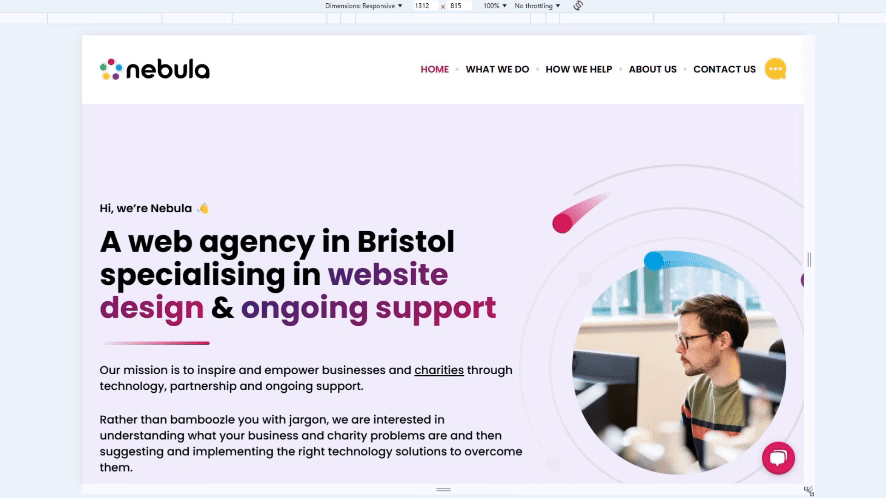These days, a nonprofit’s website is more than a digital business card. It’s a gateway to your cause, a storytelling platform, and often the first real interaction a supporter will have with your organisation. When designed and managed well, it becomes one of your most powerful tools for building trust, raising funds, and engaging a community around your mission.
To achieve that, your site needs more than a sleek design or a catchy tagline. It must be rooted in strategy, user-focused, and emotionally resonant.
With insights from nonprofit marketing experts and successful digital campaigns, this article explores what makes a truly effective nonprofit website and how partnering with a full-service marketing agency can elevate your impact.
75%
of donors seek concrete information on the charity’s achievements before deciding to contribute
1. A clear mission and tangible impact
Clarity builds confidence. Within the first few seconds of visiting your homepage, users should understand who you are, what you stand for, and how you’re making a difference.
“Your mission isn’t just a statement-it’s a promise. Make sure it’s clear, authentic, and backed by results.”
Team Allegiance, Nonprofit Marketing Resource
This doesn’t require paragraphs of explanation. In fact, brevity and power go hand in hand. A short, prominent mission statement, ideally no more than two sentences, should be front and centre on your homepage.
Add credibility with proof: This could be a counter displaying the number of lives impacted, a rotating testimonial carousel, or case studies from real people your organisation has helped. A study by Root Cause found that 75% of donors seek concrete information about a charity’s achievements before deciding to contribute. This indicates a strong preference for transparency regarding a charity’s impact.
Pro tip: Use data and emotion. Show your impact in numbers but bring it to life with a human story.
2. Simple, secure, and prominent donation options
If supporting your cause is complicated, fewer people will do it. Your “Donate” button should be immediately visible ideally in your site header and consistent across every page. Make it visually distinct and use urgent but warm language (e.g. “Make a Difference Today”).
Ensure the donation form itself is mobile-friendly, easy to use, and optimised for conversions. Platforms like Classy and Donorbox offer embeddable forms with features such as one-click giving and recurring donation prompts.
“Nonprofit websites that integrate seamless giving tools raise 2.5 times more than those without.”
Network for Good
Recurring donations matter:
“…the change in monthly giving outpaced the change in one-time giving. The precise numbers change each year — in 2024, revenue from monthly gifts increased by 5%, while revenue from one-time gifts held flat. …year by year, monthly giving rises faster than one-time giving…”
Mrbenchmarks
3. Powerful visual storytelling
Humans connect through stories. They remember faces, moments, and emotions not stats and jargon. That’s why photography, video, and authentic visuals are crucial to building empathy and trust.
Use high-quality images of your staff, volunteers, and beneficiaries (with consent). Short videos less than 2 minutes are excellent for homepage banners or campaign pages.
Emotional connection drives giving: Research from the Journal of Marketing Research found that people are significantly more likely to donate when exposed to a single compelling story than to abstract data alone.
Your visual identity should also be consistent colours, fonts, and photo style all help reinforce your brand’s credibility.
4. Mobile-first and fully accessible design
It’s no longer optional: your website must work beautifully on smartphones. As of 2024, over 60% of nonprofit web traffic comes from mobile devices (Google Analytics benchmark data).
Ensure your site is:
- Responsive on all screen sizes
- Fast to load (under 3 seconds is ideal)
- Simple to navigate with large, tappable buttons
Accessibility is just as critical. Following WCAG 2.1 guidelines not only ensures you’re inclusive of people with disabilities it also boosts SEO and enhances the user experience for everyone.
“Accessibility is usability. If your site isn’t accessible, it isn’t working for everyone and that means missed opportunities to connect.”
UK Charity Digital Skills Report

5. Clear ways to get involved
Your supporters want to help but they need direction. Offer clear, diverse paths for engagement: volunteering, attending events, fundraising on your behalf, or simply signing up for updates.
Each option should be visible on your homepage and supported by its own landing page with specific benefits and next steps.
Newsletter sign-ups remain powerful. According to Campaign Monitor, email marketing delivers a £36 return for every £1 spent. Use a simple sign-up form with a strong reason to subscribe (e.g. “Get inspiring stories and urgent updates every month”).
6. Regularly updated news and events
An outdated site suggests an inactive organisation. If your last blog post is from 2021 or your events calendar is blank, visitors might assume your work has stalled.
Post regular updates this could be short news items, blog entries, or upcoming events. It keeps your community informed and improves your search engine visibility.
“Websites that blog regularly generate 55% more traffic and 67% more leads than those that don’t.”
HubSpot
Keep your content manageable: one post per month is enough to stay current without overwhelming your team.
7. Authentic ‘About us’ and team pages
People don’t give to organisations they give to people. That’s why your About page should include more than just your mission statement. Share your origin story, values, and the journey you’ve taken so far.
Introduce your team and board members with real photos and bios. Human faces build trust and make your cause more relatable.
Include diversity: Showcase the range of voices behind your mission. Representation matters internally and externally.
8. Social proof and trust indicators
In a crowded digital landscape, trust is currency. Back up your claims with real-world validation.
This might include:
- Testimonials from service users, donors, or partners
- Logos of media outlets or foundations that support your work
- Certifications (e.g. Charity Commission registration, NCVO membership)
- Financial transparency link to your annual reports or audits
According to Nielsen, 92% of people trust recommendations from individuals (even strangers) over brands. Use that to your advantage by highlighting positive feedback from your community.
9. Integration with social media and email marketing
Your website should act as a hub, not a silo. Link your social channels clearly ideally in your footer and header. Consider embedding Twitter/X or Instagram feeds to showcase live engagement.
Similarly, your email strategy should feed back into your site. Include newsletter archive pages, subscriber-exclusive content, and sign-up forms on key pages (not just the homepage).
Cross-channel integration increases donor retention. Studies show multi-channel donors give up to 300% more over their lifetime than single-channel supporters (Blackbaud Institute).
10. Built on a manageable, flexible CMS
You shouldn’t have to call a developer every time you want to update a headline or change a photo. Choose a content management system (CMS) that fits your team’s technical comfort level and future growth.

Popular nonprofit-friendly CMS platforms:
- WordPress – Open-source, highly customisable, large community
- Squarespace – Great for small teams, easy drag-and-drop editing
- Drupal – Best for large or complex nonprofits, more technical
- Wix – Simple to manage, all-in-one features
Look for options that integrate with your CRM, donation platform, and email marketing tools. Scalability and ease of use should guide your decision.
Why work with a nonprofit marketing agency?
Even the best ideas fall flat without strategy and execution. A full-service nonprofit marketing agency brings expertise, bandwidth, and outside perspective to help you move faster and smarter.
Here’s how they can support your mission:
1. Strategic alignment
An agency can help you connect your website’s content and structure to your larger organisational goals. That includes setting measurable KPIs, identifying audience segments, and prioritising user journeys.
2. Unified branding
They ensure your website, emails, social media, and printed materials all speak with one cohesive voice strengthening your message and making you more memorable.
3. Content creation
From blog posts and case studies to fundraising videos and social graphics, agencies can create professional, mission-aligned content that resonates.
4. Campaign planning and execution
Need help launching your end-of-year appeal or Giving Tuesday campaign? Agencies offer the planning, copywriting, design, and technical setup to run effective campaigns from start to finish.
“Working with a specialised agency helped us triple our donor base in two years and finally connect all our channels into one coherent message.”
Emma T., Communications Manager, UK-based Animal Rescue Nonprofit
5. Analytics and optimisation
Good agencies don’t just launch and leave. They track performance, provide insights, and help you iterate so your website gets stronger over time.
Final thoughts
Your nonprofit website is more than a digital brochure it’s your frontline tool for building relationships, raising funds, and sharing the stories that drive your mission.
It should be beautiful, yes but also purposeful, inclusive, and easy to use. It should offer visitors not just information, but inspiration and clear next steps.
And you don’t have to do it all alone. With the right tools, partners, and mindset, your website can become a true engine of growth.
Resources and further reading
- Blackbaud Institute Resources – Research on donor engagement and giving trends
- What Every Nonprofit Website Should Include – Team Allegiance
- 7 Ways a Full-Service Nonprofit Marketing Agency Will Help You Grow – CACPRO
- M+R Benchmarks 2024 – Data on digital fundraising and nonprofit engagement
- UK Charity Digital Skills Report – Accessibility, tech adoption and strategy in UK charities
- Nonprofit Tech for Good – Trends in donor behaviour and tech tools


